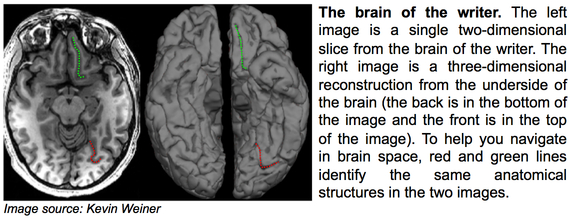
It's 7:30 a.m. and I've had my morning coffee already. I'm taking off my belt and emptying my pockets. It's that time again -- I'm getting my brain scanned. I should clarify that I'm not taking off my belt in a Magic Mike sort of way, but instead, in a brain mapping sort of way. Magnetic Resonance Imaging - or MRI - has a strong magnetic field. For example, the machine I am about to enter has a magnetic field tens of thousands of times stronger than earth's magnetic field. Because my belt has a metal buckle, the strong magnetic field will suck the belt straight from the loops of my pants and whip any and everything in its path if I keep it on. So instead, to keep everyone safe, it's best that I take it off.
Like many brain mappers, I've been getting my brain scanned and mapped voluntarily for about over a decade because, well, why not? I like knowing my brain -- mapping out dozens of areas, participating in experiments, and contributing to basic science. Oddly enough, as these experiments require you to lie down for about an hour and a half, you don't want to have to pee for that whole time and bladder control is key -- as perhaps best told by renowned cognitive neuroscientist Nancy Kanwisher in her TED talk. The best part about participating in these experiments is that you finally get to meet -- and even shake hands with -- your brain. Perhaps even better is that you don't have to be a brain mapper by trade in order to get your brain scanned.
We all go to the doctor, they tell us about our heart, our guts, our blood -- about what we're doing wrong and what we're doing right, but what about our brains? Have you ever met your brain? Do you want to while you're alive? Back in the day, Burt Green Wilder worked really hard to convince people to donate their brains to science. Though he was a surgeon in the Civil War and died in the 1920s, his brain collection and brain donor program are still being written up in the New York Times today because his approach was revolutionary - he simply asked people to sign a brain donor form. Unlike Wilder's 'brain bequest,' these days you don't have to be dead to participate in neuroscience research. In fact, it's ideal if you're alive and you can actually get paid for it! That's right, someone else will pay you to meet your own brain and even let you walk home with images or a 3-D printed version of your brain in the palm of your hand.
So what's it like? The first time is strange -- you feel like someone's seeing inside your head -- literally -- because images of your brain are popping up on their screen, but not yours. Instead, you are likely performing a particular task related to their experiment and are also likely trying not to move as this powerful magnet takes images of your brain as you think -- and they watch. Deviously voyeurish? Nah, not really.
The truth is, we as brain mappers don't know what you're thinking and we don't know what thought looks like on these images. So, it's not invasive at all. I've been scanned hundreds of times at this point and it's rather therapeutic. The whirring of that huge magnet becomes peaceful and during the second half hour of the experiment you enter a flow state of just being locked in to the experience -- almost like going for a long run or being in virtual reality. Now, participating in brain mapping experiments isn't for everyone. If you have metal in your body or you're claustrophobic, these experiments aren't for you. But, for the rest of you, maybe you want to give it a try. After all, your brain is between your ears whether you like it or not and unlike a century ago, you actually have an option to meet it while you're alive. So, why not? We also know that brain scanners are big and bulky and not always right around the corner from where you live, so if you can't get into one, don't worry. We've got you covered with articles every week that will help you learn about your brain and the many maps that it contains.
It's 9 a.m. now, the scan's over, and I'm buckling my belt. Before I leave the room outside the scanner, I grab another cup of coffee and look at the computer screen to see my brain staring back at me, and think, what an oddly refreshing world we live in.
Kevin S. Weiner is a neuroscientist, as well as member of the Organization for Human Brain Mapping (OHBM) and writes for the Communications/Media Team. The OHBM Media Team brings cutting edge information and research on the human brain to your laptops, desktops and mobile devices in a way that is neurobiologically pleasing. For more information about brain mapping, follow www.humanbrainmapping.org/blog or @OHBMSci_News

